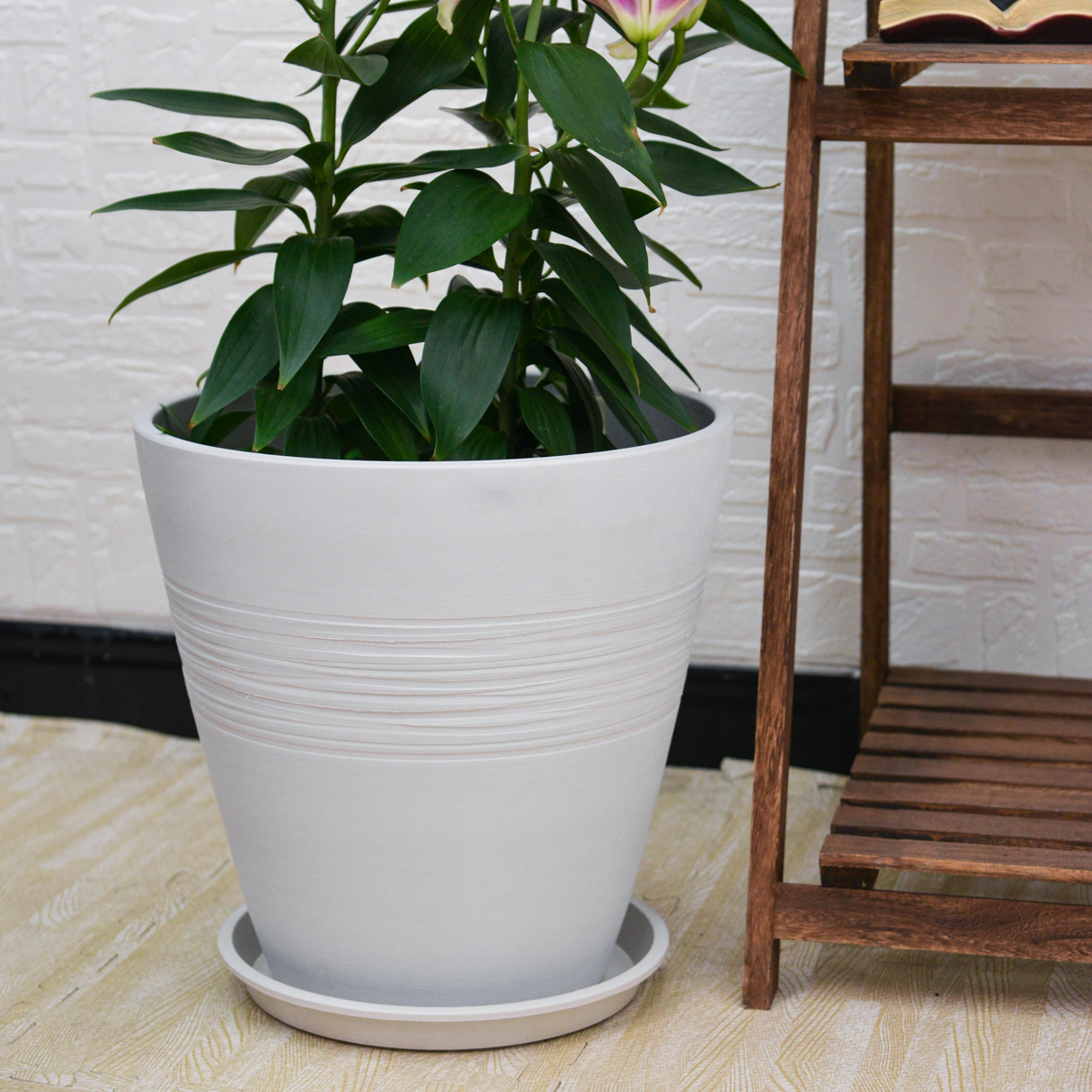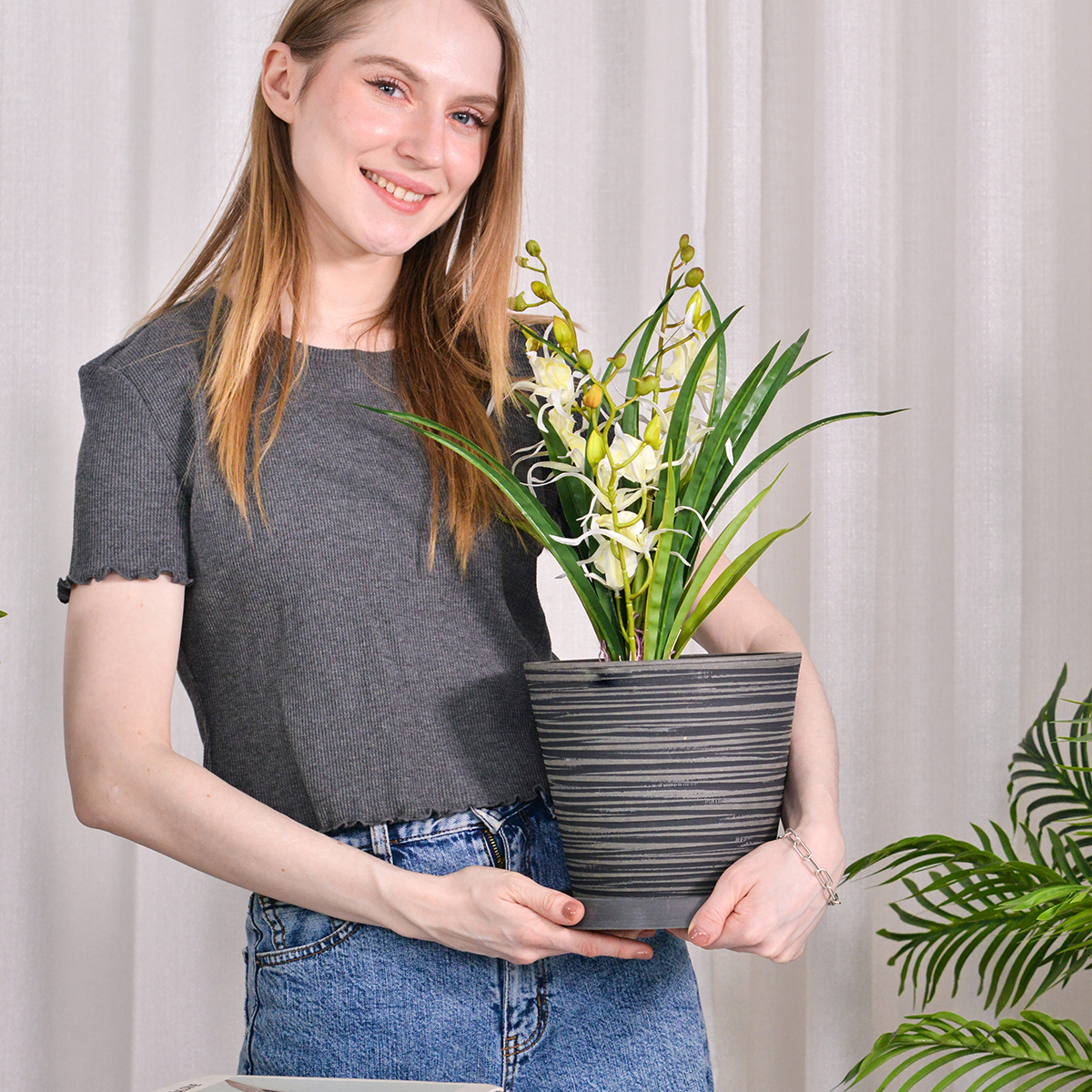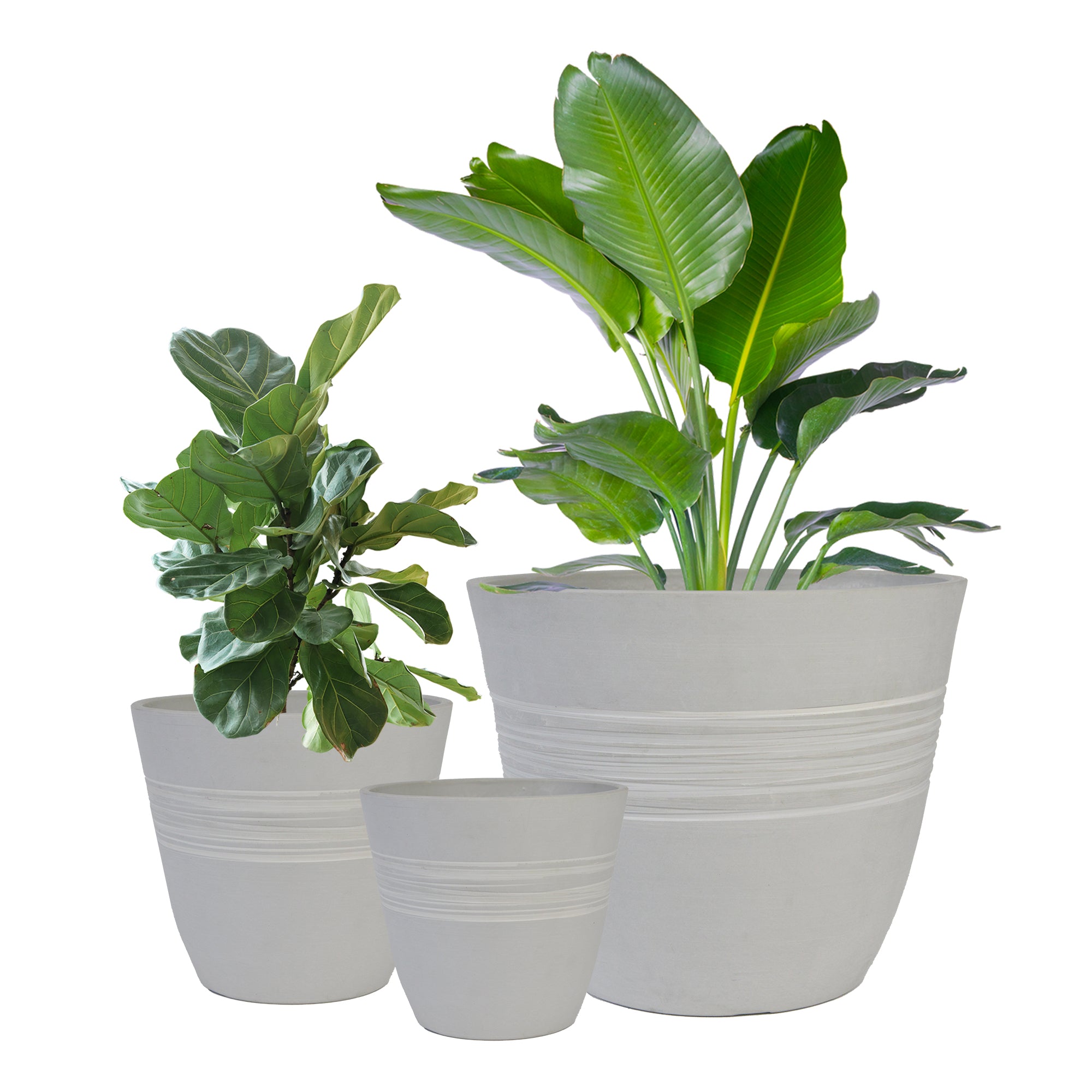Gardenias in Pots: The Ultimate Guide to Growing Fragrant Gardenias Outdoors in Containers (Tips & Care!)
Want to fill your patio, balcony, or garden with the intoxicating fragrance and classic beauty of Gardenias? Growing Gardenias (Gardenia jasminoides) in containers is a wonderfully rewarding way to enjoy these exquisite, fragrant flowers, even in limited spaces. Celebrated for their creamy white, intensely fragrant blooms, their glossy, evergreen foliage, their elegant and sophisticated appearance, and their adaptability to container gardening, Gardenias are perfect for adding a touch of Southern charm and luxurious fragrance to your outdoor living areas. This comprehensive guide will provide you with everything you need to know to grow Gardenias successfully in outdoor pots, from selecting the best varieties and containers to mastering essential care techniques for a stunning and fragrant floral display.
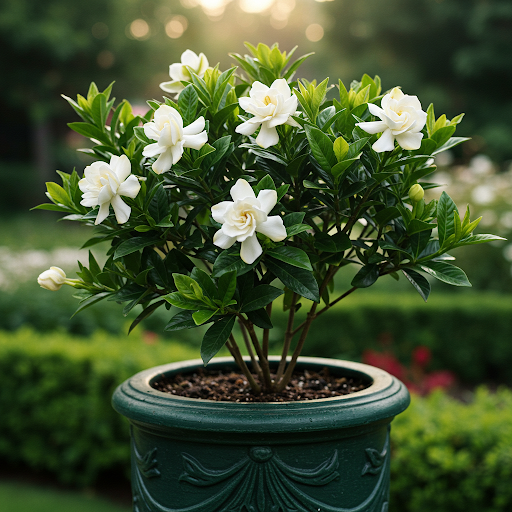
Gardenias
What are Gardenias?
Gardenias, scientifically known as Gardenia jasminoides, are beloved evergreen shrubs belonging to the Rubiaceae family (Coffee family). Native to tropical and subtropical regions of Asia, Africa, and Pacific Islands, they are widely cultivated as ornamental plants around the world, prized for their exquisite beauty, intense fragrance, glossy evergreen foliage, and classic, elegant flowers. Gardenia plants are characterized by their bushy, shrubby growth habit, their smooth, dark green, glossy leaves, and their iconic flowers that are typically creamy white, rose-like in form (often double or semi-double), and intensely fragrant, especially in the evening and morning. Flowers can range from single to fully double forms and are highly prized for their rich, sweet, intoxicating scent. They exhibit a relatively compact and upright growth habit, typically reaching heights of 2-8 feet (0.6-2.4 meters) depending on the variety and growing conditions, making them well-suited for both garden beds and container culture. Gardenias are known for their refined elegance, their popularity as cut flowers and in perfumes, their association with romance and purity, and their ability to bring a touch of Southern charm and sophistication to any garden setting.
Are Gardenias Good for Outdoor Pots?
Yes, Gardenias are exceptionally well-suited for outdoor pots and container gardening, and are a popular choice for adding fragrance and beauty to patios, balconies, entryways, and other outdoor living spaces. Their adaptability to container culture, manageable size in pots, preference for slightly acidic soil (easily controlled in pots), exquisite and fragrant flowers, and attractive evergreen foliage make them ideal for container cultivation. Growing Gardenias in pots offers several advantages:
- Ideal for Patios and Balconies: Container gardening allows you to enjoy Gardenias even if you have limited garden space, such as on balconies, patios, or decks. They bring a touch of elegance and fragrance to paved areas.
- Portability: Potted Gardenias can be easily moved to optimal locations for sunlight, display, or shelter from extreme weather. You can rearrange them to create stunning focal points or seasonal displays. Bring them indoors to protect from frost in colder climates (less relevant in Singapore, but useful for moving to sheltered locations during heavy rain).
- Controlled Soil Conditions: Container gardening allows you to provide the specific acidic, well-draining soil mix that Gardenias require and control watering and fertilization more precisely, which is crucial for their health and flowering.
- Design Versatility: Gardenias in pots can be used as standalone specimen plants in decorative pots, placed in pairs flanking doorways or entrances, grouped together for a massed fragrant display, or incorporated into mixed container arrangements with other acid-loving plants. Their upright, bushy form and elegant flowers add structure and sophistication to container gardens.
- Pest and Disease Management: Container growing can help reduce some soilborne pest and disease issues that can affect Gardenias planted directly in the ground.
- Highlighting Fragrance: Placing potted fragrant Gardenias near seating areas, windows, or walkways allows you to fully enjoy their intoxicating scents.
- Acidic Soil Preference: It is much easier to provide and maintain the acidic soil conditions that Gardenias need when growing them in pots compared to amending garden soil.
Ideal Growing Conditions for Gardenias in Pots:
Types of Gardenias for Pots: While most Gardenias can be grown in containers, some varieties are particularly well-suited due to their size and growth habits:
- Dwarf or Compact Gardenia Varieties: Look for varieties described as “dwarf,” “compact,” “patio,” or “container-friendly.” These are bred to be smaller and more manageable in pots. Examples include ‘Radicans’ (low-growing, spreading), ‘Veitchii’ (compact, classic fragrance), ‘Kleim’s Hardy’ (cold-hardy dwarf), ‘Buttons’ (very compact, small flowers).
- Medium-Sized Gardenia Varieties: Many standard Gardenia varieties can be grown in larger pots, especially when young and with regular pruning. Examples include ‘August Beauty’, ‘Mystery’, ‘Florida’, ‘Magnifica’. Be prepared to repot into larger containers as they grow.
- Grafted Gardenias: Grafted Gardenias (often grafted onto hardier rootstock) can sometimes be more vigorous and adaptable to container growing. Check the specific variety and rootstock characteristics.
- Consider Flower Form and Size: Choose varieties based on your preferred flower form (single, semi-double, double), flower size, fragrance intensity, and bloom time (early, mid, late season) to suit your preferences and container size.
Light: Gardenias thrive in bright, indirect light to partial shade. They appreciate morning sun and afternoon shade, or dappled sunlight throughout the day. When grown in pots outdoors, position them in a location that receives morning sun (east-facing location is ideal) and is sheltered from harsh afternoon sun. Avoid very intense, direct afternoon sun, especially in hotter climates like Singapore, as this can scorch leaves and buds. Bright, indirect light or filtered sun is ideal for most of the day. Too much dense shade can reduce flowering and lead to leggy growth.
Soil: Gardenias require acidic soil that is also well-draining and rich in organic matter. Use a high-quality potting mix specifically formulated for acid-loving plants (e.g., azalea, rhododendron, camellia mix). If you can’t find an acid-loving mix, amend a general-purpose potting mix with peat moss or coco coir, sulfur, and compost to lower the pH and improve acidity, drainage, and fertility. Good drainage is essential to prevent root rot, but Gardenias also appreciate consistent moisture, so the soil should be moisture-retentive but not waterlogged. Aim for a soil pH of 5.0 to 6.0 for optimal growth and flowering. You can use a soil pH testing kit to check and adjust the acidity as needed.
Watering: Gardenias prefer consistently moist soil, but they do not want to be waterlogged. Water thoroughly when the top inch of soil feels slightly dry. Water deeply until water drains out of the drainage holes. Then, allow the topsoil to slightly dry before watering again. Avoid overwatering and consistently soggy soil, which can lead to root rot, a common problem with Gardenias. Also, avoid letting the soil dry out completely, especially when plants are actively growing and blooming. Gardenias prefer a “moist but not soggy” soil environment. Watering frequency will depend on weather conditions, light levels, and pot size. Water more frequently during warmer, drier periods and less frequently during cooler, cloudier periods. Use rainwater, distilled water, or filtered water if possible, as Gardenias are sensitive to hard water and alkaline tap water, which can raise the soil pH and cause nutrient deficiencies. Avoid letting Gardenias dry out to the point of wilting, as this can cause bud drop.
Temperature: Gardenias thrive in warm temperatures, ideally between 65-75°F (18-24°C) during the growing season. They are sensitive to extreme temperature fluctuations and cold drafts. In Singapore’s consistently warm climate, temperature is generally ideal for Gardenias year-round. They can tolerate slightly higher temperatures, but may appreciate some afternoon shade in very hot climates. Protect from temperatures below 50°F (10°C), although some hardy varieties can tolerate slightly cooler temperatures. Consistent warm temperatures are beneficial for bud development and flowering.
Humidity: Gardenias prefer high humidity, reflecting their tropical and subtropical origins. Singapore’s humidity is generally well-suited to Gardenias. They appreciate humidity and good air circulation. If humidity is low, you can increase humidity around potted Gardenias by grouping plants together, using a humidity tray filled with pebbles and water, or misting them lightly in the mornings (avoid misting in the evening to prevent fungal diseases).
Fertilizer: Gardenias are moderate feeders and benefit from regular fertilization during the active growing and blooming season to support healthy growth and abundant flowering. Fertilize every 2-4 weeks during the spring and summer growing season. Use a liquid fertilizer specifically formulated for acid-loving plants (e.g., azalea, rhododendron, camellia fertilizer) or a balanced liquid fertilizer (e.g., 20-20-20 or 10-10-10) formulated for acid-loving plants. Follow product label instructions for application rates. A fertilizer slightly higher in phosphorus (the middle number) can encourage better flowering. You can also supplement with Epsom salts (magnesium sulfate) diluted in water every 4-6 weeks to enhance leaf greenness and flowering (magnesium deficiency can be common in Gardenias). Reduce or stop fertilizing during the dormant season (fall and winter) when plant growth naturally slows down. Iron deficiency can also be a problem in Gardenias, especially in alkaline soil. If you notice yellowing leaves with green veins (interveinal chlorosis), supplement with an acidifying iron chelate fertilizer according to product instructions.
Choosing the Right Pots for Gardenias:
Suitable Pot Types: Gardenias can be grown in various pot types, but good drainage, acidity, and appropriate size are important. Suitable pot types include:
- Terracotta Pots: Terracotta is a good choice as it provides excellent drainage and aeration, helping to prevent overwatering and root rot, and offers a classic, elegant look that complements Gardenias. Use terracotta pots with a glazed interior if possible to help retain soil acidity.
- Ceramic Pots (Glazed): Glazed ceramic pots are also suitable and come in a wide range of decorative styles. Ensure they have drainage holes. Glazed ceramic helps retain moisture and acidity better than unglazed terracotta. Choose based on your desired aesthetic and size needs.
- Resin Pots: Lightweight, durable, available in styles mimicking terracotta or ceramic, and offer a balance of drainage and moisture retention. Resin pots are a good alternative to heavy terracotta or ceramic, and often more durable than terracotta. Choose sturdy, good quality resin pots.
- Plastic Pots (Sturdy, Dark Colors): Sturdy, good quality plastic pots can be used, especially for larger plants, as they are lightweight and durable. Ensure excellent drainage. Dark-colored plastic pots can help retain soil warmth, which Gardenias appreciate. Be careful not to overwater in plastic pots as they retain moisture.
Drainage: Good drainage is essential for Gardenias to prevent root rot. Ensure your chosen pot has drainage holesat the bottom. Avoid pots without drainage holes. Always use a drainage layer at the base of the pot (e.g., a layer of gravel or pot shards) beneath the potting mix to further enhance drainage. Elevating pots slightly on pot feet or bricks can also improve drainage and air circulation.
Pot Size: Choose pot sizes appropriate for the size and type of Gardenia and your desired display. Gardenias have moderate root systems and need room for root development and shrub growth.
- Small, Dwarf Gardenia Varieties: Start with pots that are at least 8-10 inches in diameter and depth.
- Medium-Sized Gardenia Varieties: Use pots that are 12-16 inches in diameter and depth or larger.
- Larger, More Mature Gardenias: Use pots that are 16-20 inches in diameter and depth or larger. For very mature, larger varieties, you might even need pots that are 24 inches or more in diameter.
- Depth: Pots should be at least 10-12 inches deep, and ideally 12-16 inches deep or more for larger varieties, to accommodate the root system and provide good soil volume.
Stability: Gardenias are generally not very top-heavy, but using moderately heavy pots (terracotta or ceramic) can provide good stability, especially for larger, mature shrubs or if placed in slightly windy locations. Wider pots are generally more stable than tall, narrow pots.
Color and Style: Choose pot colors and styles that complement the creamy white flowers and elegant form of your Gardenias and your outdoor décor, and enhance their sophisticated, classic appearance. Classic white, cream, pastel shades, or elegant terracotta or dark green pots can create a refined and timeless look, highlighting the purity of the white Gardenia blooms. Consider the overall style of your patio or balcony and choose pots that harmonize with the surroundings and enhance the desired elegant, fragrant garden ambiance.
Essential Care Tips for Thriving Gardenias in Outdoor Pots:
- Watering: “Keep Soil Consistently Moist but Well-Drained, Use Acidic Water if Possible”. Water thoroughly when top inch of soil is slightly dry. Use rainwater, distilled, or filtered water if tap water is hard or alkaline. Avoid overwatering and soggy soil.
- Sunlight: Provide Bright, Indirect Light to Partial Shade (Morning Sun, Afternoon Shade Ideal). Place Gardenia pots in a location with morning sun and afternoon shade or bright, indirect light outdoors. Protect from harsh afternoon sun.
- Fertilizing: Fertilize Every 2-4 Weeks During Growing Season with Acid-Loving Plant Fertilizer. Fertilize regularly during the spring and summer growing season to promote healthy growth and flowering. Use acid-loving plant fertilizer or balanced fertilizer formulated for acid-loving plants. Supplement with Epsom salts and iron chelate if needed. Reduce or stop fertilizing during dormancy.
- Acidic Soil pH: Maintain Soil pH Between 5.0 and 6.0. Use Acidic Potting Mix and Acidifying Amendments.Use acid-loving plant potting mix. Amend with peat moss, sulfur, or acidifying fertilizers to maintain acidity. Monitor pH and adjust as needed.
- Pruning (Light Pruning After Flowering): Prune Gardenias lightly after flowering to maintain shape, remove dead or crossing branches, and encourage bushier growth. Avoid heavy pruning.
- Deadheading (Optional, for Neatness): Deadheading spent flowers (removing faded blooms) is not strictly necessary, but it can improve the plant’s appearance and prevent spent flowers from becoming brown and unsightly.
- Bud Drop Prevention (Consistent Moisture, Humidity, Avoid Stress): Bud drop (buds falling off before opening) is a common issue with Gardenias, often caused by inconsistent watering, dry air, temperature fluctuations, or stress. Provide consistent moisture, high humidity, and a sheltered location to minimize bud drop.
- Pest and Disease Control: Monitor for common pests like aphids, mealybugs, spider mites, and whiteflies. Treat promptly with insecticidal soap or horticultural oil if needed. Root rot is the most common disease issue, caused by overwatering and poor drainage. Prevent root rot by ensuring excellent drainage and proper watering practices. Fungal diseases can occur in humid conditions; ensure good air circulation.
Popular Gardenia Cultivars for Pots (and Flower Types/Fragrance):
Gardenia cultivars vary in size, flower form, and fragrance intensity.
- Highly Fragrant Gardenias: ‘August Beauty’ (classic strong fragrance, double flowers), ‘Mystery’ (intense fragrance, large double flowers), ‘Veitchii’ (compact, very fragrant, semi-double flowers), ‘Fragrant Star’ (strong fragrance, single flowers, more cold-hardy).
- Dwarf and Compact Gardenias: ‘Radicans’ (very low-growing, spreading, small single flowers, light fragrance), ‘Buttons’ (very compact, small double flowers, light fragrance), ‘Kleim’s Hardy’ (cold-hardy dwarf, semi-double flowers, fragrant).
- Large-Flowered Gardenias: ‘Mystery’ (very large double flowers, strong fragrance), ‘Florida’ (large double flowers, fragrant), ‘Magnifica’ (large double flowers, fragrant).
- Cold-Hardy Gardenias (for cooler climates, less relevant in Singapore): ‘Kleim’s Hardy’, ‘Chuck Hayes’, ‘Frostproof’, ‘ ঘাস ‘.
In Summary:
Growing Gardenias (Gardenia jasminoides) in outdoor pots is a wonderfully rewarding way to create a fragrant and elegant container garden. Their exquisite, creamy white flowers, intoxicating fragrance, and glossy evergreen foliage make them a perfect choice for container gardeners of all levels, especially those seeking refined, fragrant, and relatively low-maintenance shrubs for patios, balconies, and entryways. By providing bright, indirect light to partial shade, acidic, well-draining potting mix in pots with good drainage, keeping the soil consistently moist but not waterlogged, regular fertilizing with acid-loving plant food, and choosing pot sizes appropriate for the variety, you can easily cultivate thriving and spectacularly blooming Gardenia plants in pots and enjoy their classic beauty and luxurious fragrance in your outdoor living spaces year after year.
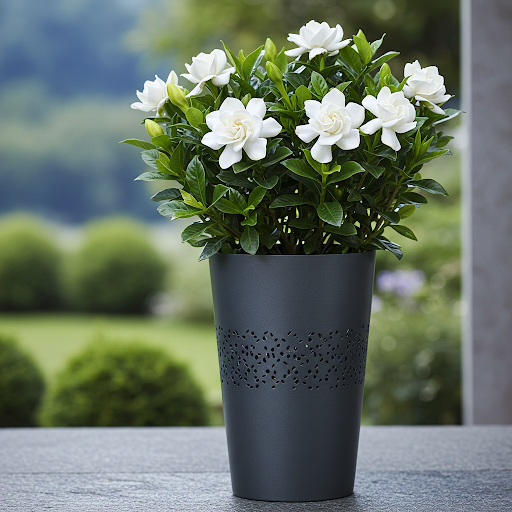
Gardenias
For more detailed botanical information and to explore the captivating world of Gardenias, you can visit the Wikipedia page on Gardenia jasminoides.
Important Note: The key to success with Gardenias in pots is providing acidic soil, consistent moisture (without overwatering), protection from harsh afternoon sun, and regular fertilization with acid-loving plant food. With proper care and a suitable location, your potted Gardenias will reward you with years of exquisite beauty and intoxicating fragrance, bringing a touch of Southern elegance to your container garden!
KC3-14A
By greenship|2024-08-16T06:26:30+00:00August 16, 2024|Categories: Hand-carving Series|
KC2-GS
By greenship|2024-08-16T06:30:21+00:00August 16, 2024|Categories: Hand-carving Series|
k2-21G
By greenship|2024-08-13T06:17:26+00:00August 13, 2024|Categories: Hand-carving Series|
K2-11T
By greenship|2024-08-13T04:21:25+00:00August 13, 2024|Categories: Hand-carving Series|
Plant Pots 6 inch 8 inch 12 inch for Indoor Outdoor Plants, Set of 3 Modern Decorative Planter with Drainage Hole, Decorative Flower Pots
By greenship-seo|2025-04-10T06:38:40+00:00January 16, 2025|Categories: Hand-carving Series|Tags: Decorative Flower Pots|
Planter 6 in W / 8 in W / 12 in W Indoor or Outdoor Plants, Modern Decorative Plant Pots with Drainage Hole, Decorative Flower Pots
By greenship-seo|2025-02-06T13:43:53+00:00January 16, 2025|Categories: Hand-carving Series|Tags: Decorative Flower Pots|


